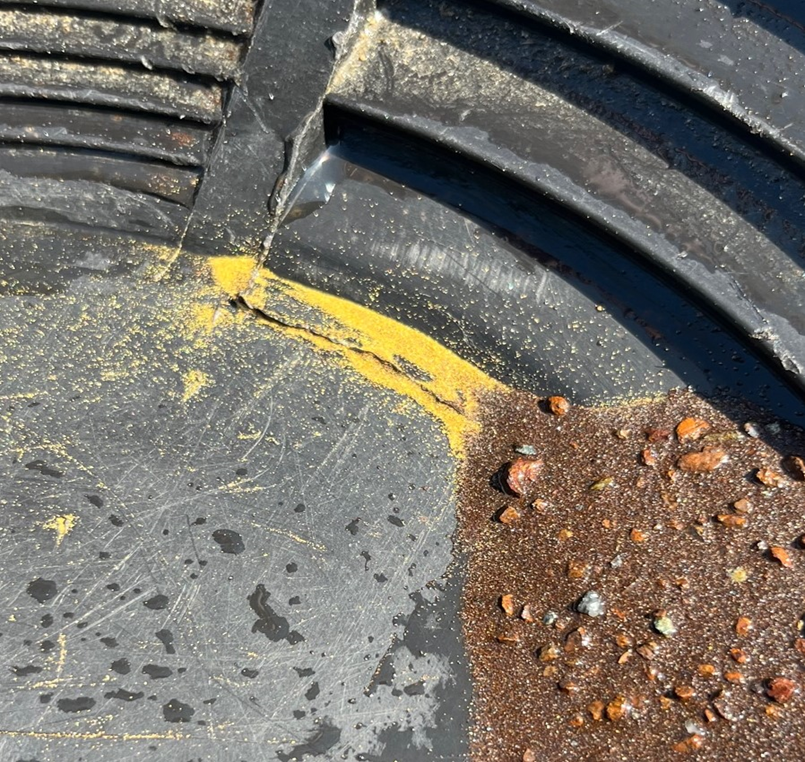Detailed prospecting to begin in August ahead of trenching/drilling
ST. JOHN'S NL / ACCESSWIRE / July 7, 2023 / Sokoman Minerals Corp. (TSXV:SIC)(OTCQB:SICNF) (the "Company" or "Sokoman") is pleased to provide an update on the planned exploration of the Fleur de Lys gold project on the Baie Verte Peninsula, in north-central Newfoundland. Company geologists and prospectors recently toured gold systems in Dalradian / Caledonian rocks in Northern Ireland which are equivalent to the Appalachian, Fleur de Lys Supergroup rocks, including mineralization in and around the world-class Curraghinalt gold deposit. Curraghinalt is host to >6 million ounces of NI 43-101 compliant* gold resources in 20+, discrete quartz veins ranging from tens of centimeters to more than 1.5 m in thickness. The veins have strike lengths in excess of 1.8 km and have been intersected in drill holes to 1,000 m vertically with the resources calculated by SRK Consulting (Canada) in 2018 to a 400 m depth. Curraghinalt, which remains open at depth, is the largest gold deposit in the Appalachian-Caledonian Orogen.
Tim Froude, President and CEO of Sokoman, commented: "We are extremely thankful for the opportunity to visit Northern Ireland and examine the geological setting of gold in Dalradian rocks of the Sperrin Mountains and adjacent terranes to aid in our broader assessment of Sokoman's Fleur de Lys gold project. A week in the field and underground, viewing core from the deposits, and meetings with the British Geological Survey (BGS), industry geologists, and local prospectors, has been invaluable in helping our team understand i) the controls on gold deposition in the very familiar-looking Dalradian rocks, and ii) gold exploration strategies that have proven successful in this segment of Irish/UK Caledonides. Several crucial elements pertaining to the distribution of gold in Dalradian rocks are directly applicable to evaluating Sokoman's gold in till anomalies at Fleur de Lys including 1) the regional structural setting; 2) the absolute ages and relative timing of gold mineralizing events and poly-phase tectonism; 3) vein styles, and proximity to the Clew-Bay/Omagh crustal-scale terrane boundary - the Baie Verte Line equivalent; 4) local, specific, lithological controls; 5) the proximity to gold-rich VMS in adjacent terranes; and 6) the physical nature and distribution of the gold at Curraghinalt.
This data highlighted the critical commonalities, vis-à-vis gold, between the Sperrin Mountains (e.g., Curraghinalt) and the Fleur de Lys belt at regional, property, and outcrop scales. Our mission in Northern Ireland was to learn about gold in this part of the world and apply it to exploration plans in the Fleur de Lys belt in Newfoundland. Given what we learned, we left even more confident about the potential of our Fleur de Lys gold project. The Company, with input from Overburden Drilling Management, is prioritizing the anomalies for a detailed follow-up prospecting program beginning in August, with significant results to be further explored by trenching or diamond drilling."
Gold-bearing quartz float; Curraghinalt gold deposit underlies the field in the foreground

Exposure of gold-bearing quartz vein in graphitic schist and psammite near Curraghinalt

Narrow high-grade quartz-pyrite (gold bearing) vein near Curraghinalt

About the Fleur de Lys Gold Project
The 100%-owned project is located on the west side of the Baie Verte Peninsula in north-central Newfoundland. The area has a long history of base metal and gold production dating back to the 1860s. The project is highly prospective for Dalradian-style (e.g., Curraghinalt) orogenic, vein-hosted, gold deposits and as such, represents a readily accessible, yet underexplored, district-scale, gold target in the Newfoundland Appalachians. The Fleur de Lys Supergroup, which underlies the project, includes equivalent rocks to the Dalradian Supergroup in the UK, where three significant gold deposits, including the Curraghinalt and Cavanacaw deposits in Northern Ireland, and Cononish in Scotland are found. The Dalradian, vein-hosted, gold deposits occur in moderate to high-grade metamorphic terranes and are typically high grade.
Prior to Sokoman's exploration, the Fleur de Lys belt had seen little modern exploration with some areas completely unexplored, even though historical grab sample values of 3.3 g/t Au to 25.5 g/t Au were reported from several locations (note: historical assays have not been verified by the Company and should not be relied upon). Sokoman's Fleur de Lys property is ideally suited to cost-effective exploration with excellent access and infrastructure, a supportive local population, a long history of mining, and support businesses.
To date, the Company has completed a property scale C-horizon till sampling program (1,260 samples) implemented and overseen by Overburden Drilling Management (ODM), which has outlined strongly anomalous gold in tills overlying favourable rocks and structures with significant gold values in both float and bedrock. The background level of gold grains in tills for the project has been determined to be 10 grains in a 10- to 12-kilogram sample of screened till. ODM considers a Fleur de Lys sample to be anomalous if it contains two-times background or 20 gold grains. Results indicate that of the 1,260 samples collected, 328 samples, or just over 25%, have at least 20 gold grains (to a maximum of 230 grains) and are considered anomalous. Fifty-five (55) samples contain at least 60 grains (six-times background) with multiple samples containing more than 50% pristine gold grains. Gold grains described as pristine are considered to be from a local bedrock source. Of note - most gold grains at Fleur de Lys are small (<1 mm) as is most of the gold at Curraghinalt, where gold is intimately associated with pyrite mineralization in quartz veins.

In addition, limited prospecting has located anomalous gold in bedrock and float with 34 samples giving gold values >100 ppb Au (0.1 g/t Au), including 18 samples >500 ppb Au (0.5 g/t Au), and 10 samples >1000 ppb Au (>1.0 g/t Au) with a maximum of 6.2 g/t Au. The highest gold value was in an outcrop (a grab sample) in an area of strong gold-grain counts. A regional airborne magnetic survey (Geological Survey of Canada (GSC) - 2015) over the Baie Verte Peninsula suggests that multiple crosscutting structures occur in the vicinity of several strong gold in till anomalies and in multiple rock (grab and float) gold-bearing samples, all within a 5-8 km corridor adjacent to the Baie Verte Line. Interpretation of the till results by ODM defines a target area of 30 km strike-length, with better-defined anomalies located within this 30 km long area.
Panned, fine gold grains from surface vein exposure at Curraghinalt

QP
This news release has been reviewed and approved by Timothy Froude, P. Geo., a "Qualified Person" under National Instrument 43-101 and President and CEO of Sokoman Minerals Corp.
Till Sampling QA/QC
The till samples were collected by Sokoman personnel using field collection techniques provided by ODM. All samples were hand dug to the desired depth (C-Horizon Till) with a 10- to 12-kg sieved sample (8 mesh) placed in a clear plastic sample bag and sealed. Samples were shipped in plastic pails by bonded courier to the ODM lab in Ottawa, Ontario. The till samples are processed using procedures designed to progressively concentrate the heavy minerals, expose the gold grains and prepare a split of the heavy mineral concentrate ("HMC") suitable for geochemical analysis if requested. The sample is wet screened at 2 mm with a preliminary concentrate extracted from the -2 mm fraction by tabling. Geological observations on the character of the sample are made during both the screening and tabling operations. The table concentrate is purposely large (typically 300-400 g) and of low grade (10%-25% heavy minerals) in order to achieve a high, 80% to 90% recovery rate for all desired heavy minerals irrespective of their grain size or relative specific gravity. The gold grains, more than 95% of which are normally silt-sized (Averill 2001), are observed at this stage with the aid of micro-panning and are counted, measured, and classified as to degree of wear (ie distance of glacial transport), then returned to the table concentrate. The pyrite content of the pan concentrate is estimated and the number of grains of heavier, visually distinctive indicator minerals such as arsenopyrite, galena, scheelite, cinnabar, etc. is recorded.
Quality Control and Quality Assurance Measures
In addition to using field duplicates to monitor the quality of the indicator mineral data obtained from specific projects, ODM performs blind tests to ensure that the recovery rates for all targeted minerals are consistently in the 80% to 90% range. Furthermore, both the quality of the mineral separation and the overall mineralogy of the concentrate are visible at every stage of the concentration process, minimizing the potential for sample mix-ups, indicator mineral carryover between samples, and other potential contamination issues. For example, gold grains, which are the most important indicator mineral on many surveys, are more susceptible to inter-sample carryover than any other indicator mineral due to their very small size, but these grains are physically observed during the first stage of mineral concentration, tabling, and if anomalous concentrations are present, blank samples are tabled and carefully inspected for gold grains before the next project sample is processed.
Rock Sample Analysis
Rock sample analysis (gold by fire assay) completed at Eastern Analytical Ltd., in Springdale NL. Samples were delivered in sealed bags directly to the lab by Sokoman Minerals' personnel. Eastern Analytical is an accredited assay lab that conforms to the requirements of ISO/IEC 17025. Eastern routinely inserts industry-accepted standards and blanks in all sample runs performed as well as completing random duplicate analysis.
About Sokoman Minerals Corp.
Sokoman Minerals Corp. is a discovery-oriented company with projects in the province of Newfoundland and Labrador, Canada. The Company's primary focus is its portfolio of gold projects; the 100%-owned flagship, advanced-stage Moosehead, as well as Crippleback Lake (available for option); and East Alder along the Central Newfoundland Gold Belt, and the district-scale Fleur de Lys project near Baie Verte in north-central Newfoundland, that is targeting Dalradian-type orogenic gold mineralization similar to the Curraghinalt and Cavanacaw deposits in Northern Ireland. The Company also entered into a strategic alliance with Benton Resources Inc. through three, large-scale, joint-venture properties including Grey River, Golden Hope, and Kepenkeck in Newfoundland.
Sokoman now controls, independently and through the Benton Alliance, over 150,000 hectares (>6,000 claims - 1500 sq. km), making it one of the largest landholders in Newfoundland, in Canada's newest and rapidly-emerging gold districts. The Company also retains an interest in an early-stage antimony/gold project (Startrek) in Newfoundland, optioned to Thunder Gold Corp (formerly White Metal Resources Inc.), and in Labrador, the Company has a 100% interest in the Iron Horse (Fe) project which has Direct Shipping Ore (DSO) potential.
Mineralization hosted on adjacent and/or nearby and/or referenced properties is not necessarily indicative of mineralization hosted on the Company's property.
*The Curraghinalt deposit has >6 million ounces of NI 43-101 compliant gold resources including 6.34 million tonnes at 15.01 grams per tonne (Measured and Indicated) for 3.06 million ounces; and 7.72 million tonnes at 12.24 grams per tonne gold (Inferred) for 3.03 million ounces {2018 Mineral Resource Statement, Curraghinalt Gold Project, Northern Ireland, SRK Consulting (Canada)}.
The Company would like to thank the Government of Newfoundland and Labrador for past financial support of the Fleur de Lys project through the Junior Exploration Assistance Program.
For further information, please contact:
Sokoman Minerals
Timothy Froude, P.Geo., President & CEO
Phone: 709-765-1726
Email: tim@sokomanmineralscorp.com
Cathy Hume, VP Corporate Development, Director
Phone: 416-868-1079 x251
Email: cathy@chfir.com
Website: www.sokomanmineralscorp.com
Twitter: @SokomanMinerals
Facebook: @SokomanMinerals
LinkedIn: @SokomanMinerals
Neither the TSX Venture Exchange nor its Regulation Services Provider (as that term is defined in the policies of the TSX Venture Exchange) accepts responsibility for the adequacy or accuracy of this release.
Investors are cautioned that trading in the securities of the Corporation should be considered highly speculative. Except for historical information contained herein, this news release contains forward-looking statements that involve risks and uncertainties. Actual results may differ materially. Sokoman Minerals Corp. will not update these forward-looking statements to reflect events or circumstances after the date hereof. More detailed information about potential factors that could affect financial results is included in the documents filed from time to time with the Canadian securities regulatory authorities by Sokoman Minerals Corp.
SOURCE: Sokoman Minerals Corp.
View source version on accesswire.com:
https://www.accesswire.com/766157/Sokoman-Minerals-Provides-Update-on-Fleur-de-Lys-Gold-Project-North-Central-Newfoundland






